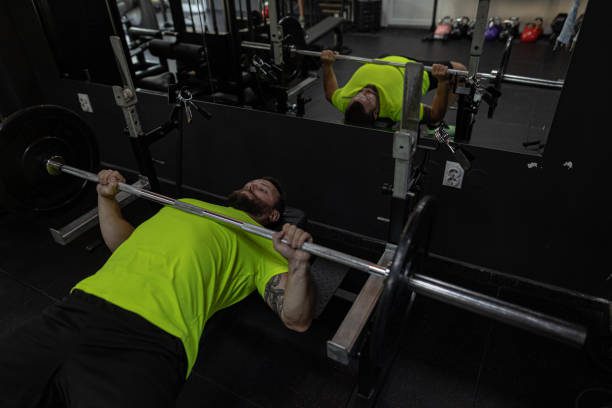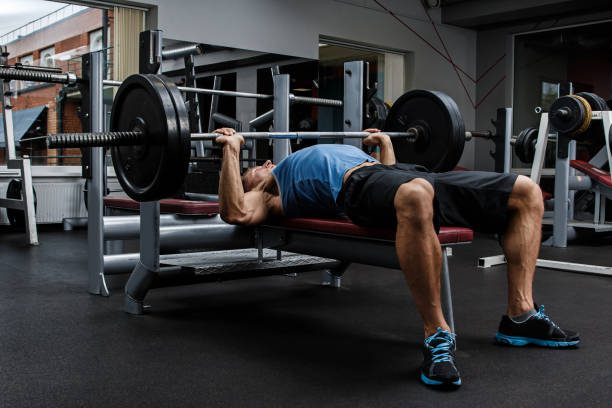This content is for informational and educational purposes only. Always consult a qualified healthcare provider.
Last Updated on February 5, 2024 by Grace Oluchi
Get ready to pump up those muscles and feel the burn with the bench press workout! This exercise not only strengthens your chest, but also engages your shoulders, triceps, and core. With 200% active involvement, the bench press is a great way to build upper body strength and tone your muscles. So, let’s get started and feel the burn!
📋 Table of Contents
The Bench Press Muscle Work.
The bench press is a compound exercise that primarily works the chest muscles (pectoralis major and minor), shoulders (deltoids), and triceps. However, it also engages several other muscles in the upper body, including the biceps, forearms, and upper back muscles. Additionally, the bench press can also engage the core muscles, particularly the abdominals and obliques, as they work to stabilize the body during the exercise. Overall, the bench press is a great exercise for building upper body strength and muscle mass.
Benefits.
Here are some of the benefits of the muscle work:
- Builds muscle mass: it is a compound exercise that works multiple muscle groups, making it an effective way to build muscle mass in the chest, shoulders, and triceps.
- Increases upper body strength: By working the chest, shoulders, and triceps, it can help increase overall upper body strength.
- Improves pushing power: it is a pushing exercise that can help improve your pushing power, which can be beneficial for a variety of activities, such as sports, weightlifting, and everyday tasks.
- Enhances muscular endurance: it can also help improve muscular endurance, allowing you to perform more reps and sets of other exercises.
- Improves bone density: Strength training exercises like the bench press have been shown to improve bone density, which can reduce the risk of osteoporosis and other bone-related conditions.
- Burns calories: it can also help burn calories, making it a great exercise for those looking to lose weight or maintain a healthy weight.
- Improves posture: it can also help improve posture by strengthening the muscles of the upper back and shoulders, which can help prevent hunching and slouching.
How to do the Bench Press Muscle Work.
Here are the steps to perform the muscle work:


1. Lie flat on a bench with your feet firmly planted on the ground. Your head, shoulders, and glutes should be in contact with the bench.
2. Grip the barbell with your hands slightly wider than shoulder-width apart. Your wrists should be straight.
3. Lift the bar off the rack, keeping your arms straight and your elbows locked.
4. Slowly lower the bar towards your chest while inhaling, keeping your elbows tucked in close to your body.
5. Pause briefly when the bar touches your chest, then exhale and push the bar back up to the starting position, keeping your elbows locked.
6. Repeat for the desired number of reps.
7. Once you’ve completed your set, carefully rack the bar on the bench press rack.
Tips While Doing the Bench Press.
- Keep your feet firmly planted on the ground throughout the exercise to maintain stability and prevent injury.
- Keep your elbows tucked in close to your body during the exercise to engage your chest muscles more effectively.
- Use a spotter, especially when lifting heavy weights, to prevent injury and ensure proper form.
- Start with lighter weights and gradually increase the weight as you become more comfortable with the exercise to avoid injury.
- Avoid arching your back or lifting your hips off the bench, as this can lead to injury.
Variations for the Bench Press Muscle Work.
Here are some of the most common variations:
- Incline bench press: This variation targets the upper chest muscles more than the traditional one. It is performed by adjusting the bench to a 30-45 degree angle and performing it as usual.
- Decline bench press: This variation targets the lower chest muscles more than the traditional one. It is performed by adjusting the bench to a 15-30 degree angle downward and performing it as usual.
- Close-grip bench press: This variation targets the triceps more than the chest muscles. It is performed by gripping the bar with hands closer together than shoulder-width apart and performing it as usual.
- Dumbbell bench press: This variation can help improve balance and stability in the upper body. It is performed by using dumbbells instead of a barbell and performing it as usual.
- Floor press: This variation can help improve explosive power and range of motion. It is performed by lying on the floor and performing it with the barbell starting from the floor rather than on a rack.
- Pause bench press: This variation can help improve power and strength out of the bottom position. It is performed by pausing for a few seconds when the barbell touches the chest before pressing back up.
- Single-arm bench press: This variation can help improve unilateral strength and balance in the upper body. It is performed by using a single dumbbell or kettlebell and pressing it with one arm at a time while lying on the bench.
Additional Information About the Bench Press Muscle Work.
- Frequency: it is a heavy compound exercise that requires a lot of energy and recovery time. It is generally recommended to perform it no more than 2-3 times per week, with at least one day of rest in between.
- Rep range: The ideal rep range depends on your training goals. For strength and power, a lower rep range of 1-5 is recommended. For muscle hypertrophy and endurance, a higher rep range of 8-12 is recommended.
- Warm-up: It is important to warm up properly before performing it to prevent injury and maximize performance. A good warm-up should include dynamic stretches, mobility exercises, and light sets of the bench press.
- Breathing: Proper breathing technique is important during it to maintain stability and prevent injury. Inhale deeply before lowering the bar and exhale forcefully as you push the bar up.
- Progression: In order to continue making progress with it, it is important to gradually increase the weight and intensity over time. This can be done by adding weight to the barbell, increasing the number of sets or reps, or incorporating different variations.
- Safety: it can be a safe and effective exercise when performed with proper form and technique. However, it is important to use a spotter when lifting heavy weights, and to never lift beyond your capabilities.
The Key Takeaway.
The bench press is a highly effective exercise for building upper body strength and muscle mass. By incorporating different variations and following proper training guidelines, you can maximize the benefits of this exercise and achieve your fitness goals.
What muscles does the bench press work?
The bench press primarily works the chest (pectoralis major), shoulders (anterior deltoids), and triceps, but it also engages other muscles such as the back, biceps, and core to stabilize the body during the exercise.
How can I improve my bench press strength?
To improve your bench press strength, you can focus on increasing your overall upper body strength through exercises such as push-ups, shoulder press, and tricep dips. Additionally, practicing proper form and gradually increasing the weight you lift can help improve your bench press strength.
Is the bench press a good exercise for building chest muscles?
Yes, the bench press is a highly effective exercise for building chest muscles, particularly the pectoralis major muscle. However, it is important to also include other chest exercises in your workout routine for a well-rounded chest workout.
How often should I do the bench press?
The frequency of bench press workouts depends on your fitness goals and overall workout routine, but it is generally recommended to limit bench press workouts to once or twice a week to allow for proper muscle recovery.
Are there any safety considerations to keep in mind when doing the bench press?
Yes, it is important to practice proper form when doing the bench press to avoid injury. This includes keeping your feet flat on the ground, engaging your core muscles, and keeping your elbows tucked in close to your body during the exercise. Additionally, it is important to start with a weight that you can comfortably lift and gradually increase the weight as your strength improves.

